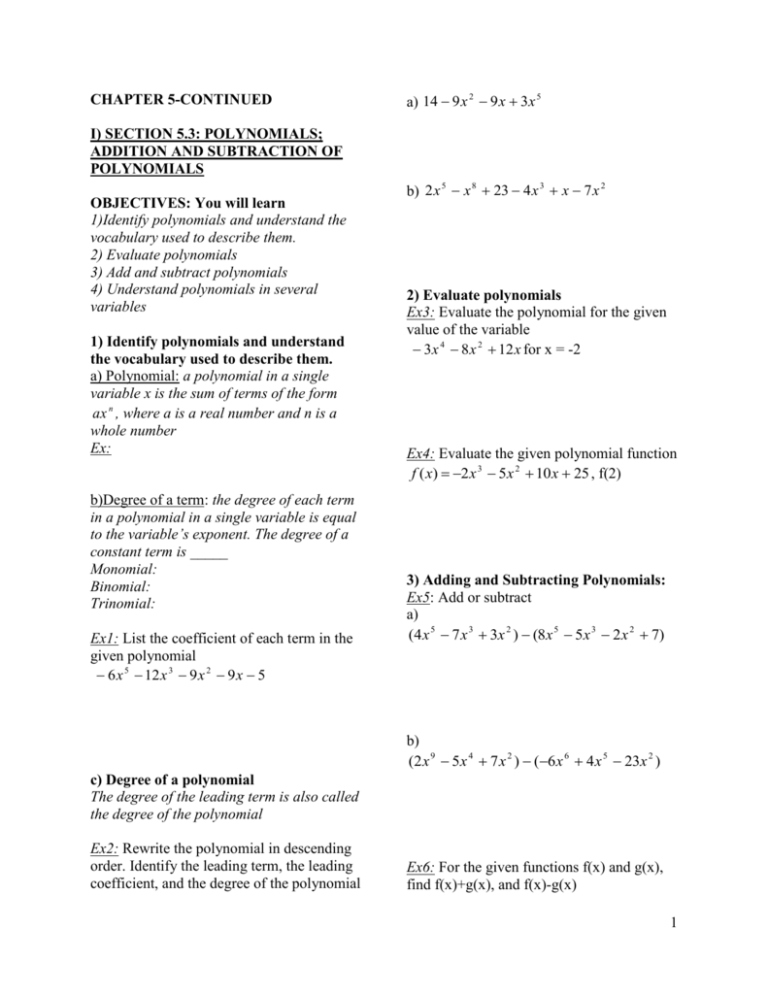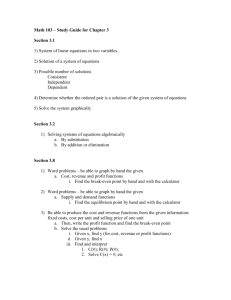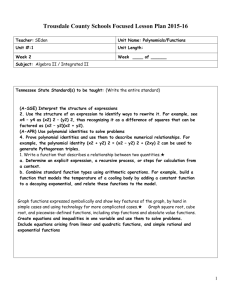Lecture notes 2
advertisement

CHAPTER 5-CONTINUED a) 14 9 x 2 9 x 3x 5 I) SECTION 5.3: POLYNOMIALS; ADDITION AND SUBTRACTION OF POLYNOMIALS OBJECTIVES: You will learn 1)Identify polynomials and understand the vocabulary used to describe them. 2) Evaluate polynomials 3) Add and subtract polynomials 4) Understand polynomials in several variables 1) Identify polynomials and understand the vocabulary used to describe them. a) Polynomial: a polynomial in a single variable x is the sum of terms of the form ax n , where a is a real number and n is a whole number Ex: b)Degree of a term: the degree of each term in a polynomial in a single variable is equal to the variable’s exponent. The degree of a constant term is _____ Monomial: Binomial: Trinomial: Ex1: List the coefficient of each term in the given polynomial 6 x 5 12 x 3 9 x 2 9 x 5 b) 2 x 5 x 8 23 4 x 3 x 7 x 2 2) Evaluate polynomials Ex3: Evaluate the polynomial for the given value of the variable 3x 4 8 x 2 12 x for x = -2 Ex4: Evaluate the given polynomial function f ( x) 2 x 3 5 x 2 10 x 25 , f(2) 3) Adding and Subtracting Polynomials: Ex5: Add or subtract a) (4 x 5 7 x 3 3x 2 ) (8x 5 5x 3 2 x 2 7) b) (2 x 9 5x 4 7 x 2 ) (6 x 6 4 x 5 23x 2 ) c) Degree of a polynomial The degree of the leading term is also called the degree of the polynomial Ex2: Rewrite the polynomial in descending order. Identify the leading term, the leading coefficient, and the degree of the polynomial Ex6: For the given functions f(x) and g(x), find f(x)+g(x), and f(x)-g(x) 1 f ( x) x 3 8 x 31, g ( x) 4 x 3 x 2 3x 25 b) The average cost per shirt, in dollars, to produce x T-shirts is given by the function f ( x) 0.00017 x 2 0.06 x 13.124 . What is the average cost per shirt to produce 100 Tshirts? 4) Polynomials in Several Variables Ex7: Evaluate the polynomial a) 3x 2 11xy y 2 for x=4, and y =3 II)SECTION 5.4: MULTIPLYING POLYNOMIALS b) 7 x 2 yz 9 xy 2 z 10 xyz 2 for x=2, y=3, z= -1 OBJECTIVES: You will learn 1)Multiply monomials 2)Multiply a monomial by a polynomial 3)Multiply polynomials 4)Find special products 1)Multiplying Monomials i)Degree of each term in the polynomial: is equal to sum of the exponents of its variable factors. Ex8: For each polynomial, list the degree of each term and the degree of the polynomial. 4 x 8 y 6 3x 3 y 7 x 5 y 11 6 x 2 y 5 z 4 Ex1: Multiply a) 8 x 2 3x 3 10 x 5 b) 5 x 4 y 3 z 14 x 2 y 9 z 3 Ex2: Find the missing monomial 2 x 9 ____ 24 x16 Ex9: Add or subtract 2)Multiply a monomial by a polynomial: a) 4 2 5 3 2 4 2 5 3 2 multiply the monomial by each term of the ( x y 7 x y 15 y z t ) (8x y 11x y 9 y z t ) polynomial Ex3: Multiply a) 4(4 x 9) 2 b) 2 x 2 y 4 (3x 4 6 xy 7 y 5 ) Ex4: For the given functions f(x) and g(x), find f ( x) g ( x) f ( x) x 4 7 x 2 8 x 5 ; g ( x) 5x 4 3)Multiply polynomials FOIL method: (a+b)(c+d) 4)Find special products (a b)( a b) Ex4: Multiply: a) (3x 2)( x 8) (a b) 2 (a b) 2 b) (7 x 5)(2 x 2 3x 15) Ex5: Find the special product using the appropriate formula a) (2 x 5)( 2 x 5) c) ( x 2 3x 2)(3x 2 x 5) b) (2 x 5) 2 c) ( x 5) 2 d) ( x 7 y )( 2 x 3 y ) Ex6: Find the missing factor or term a) ( x 5) ________ x 2 25 b) (_______) 2 x 2 12 x 36 c) (________) 2 9 x 2 12 x 4 3 III)SECTION 5.5: DIVIDING POLYNOMALS OBJECTIVES: You will learn 1)Divide a monomial by a monomial 2)Divide a polynomial by a monomial 3)Divide a polynomial by a polynomial by using long division 4)Use placeholders when dividing a polynomial by a polynomial Ex3: Divide. Assume all variables are nonzero. 22 x 5 36 x 4 14 x 2 a) 2x 2 b) 2a 10 b 8 8a 5 b 9 10a 6 b 2a 5 b 1)Divide a monomial by a monomial Ex1: Divide. Assume all variables are nonzero 24 x 9 y 10 a) 6x 5 y 8 b) (72 x y ) (10 x y ) 13 8 8 6 Ex2: Find the missing monomial. Assume x0 20 x 10 5 x 4 a) ? b) 24 x10 4x 7 ? 3 2) Divide Polynomials by Monomials To divide a polynomial by a monomial, divide each term of the polynomial by the monomial Ex4: Find the missing dividend or divisor. Assume x 0 10 x 8 50 x 5 35 x 3 2 x 5 10 x 2 7 a) ? b) ? x 2 9x 1 5 7x 3) Divide a polynomial by a polynomial by using long division Step1: Divide the term in the dividend with the highest degree by the term in the divisor with the highest degree. Add this result to the quotient Step2: Multiply the monomial obtained in step 1 by the divisor, writing the result underneath the dividend.(Align like terms vertically) Step3: Subtract the product obtained in step 2 from the dividend. Step4: Repeat steps 1-3 with the result of step 3 as the new dividend. Keep repeating this procedure until the degree of the new dividend is less than the degree of the divisor Ex5: Divide using long division 4 a) ( x 2 15x 56) ( x 7) b) b) x 3 27 x3 x 3 11x 2 37 x 17 x 1 c) ( x 5 3x 3 5 x 2 x 3) ( x 2) 4)Use placeholders when dividing a polynomial by a polynomial Ex6: Divide using long division x 3 12 x 11 a) x3 5







